Deans Court
Deans Court is a student hall of residence at the University of St Andrews originating from the XII century, thus, arguably, the oldest dwelling house in the town of St Andrews, Scotland. It stands at the east-end of St Andrews, where North street and South street converge. The entrance of the courtyard opens up to the ancient, ruined, St Andrews cathedral. The Hall is open exclusively to postgraduates, and comprises the main building and four annexes, two on North Street, two on South Street. Current residents are affectionately known as Deans Courtiers, Deans Courtesans, or Deans Beans.
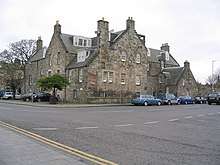
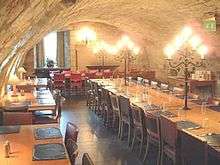
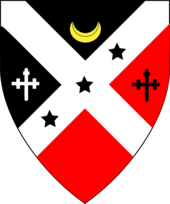
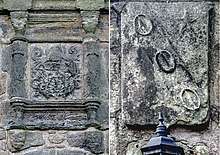
| Deans Court | |
|---|---|
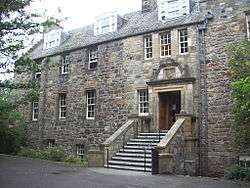 The main entrance of Deans Court | |
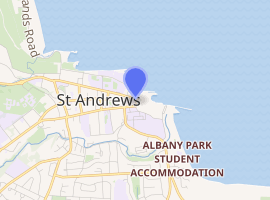
| |
| General information | |
| Type | Student residence |
| Architectural style | Scottish Vernacular |
| Address | North Street St Andrews Fife KY16 9QT |
| Town or city | St Andrews, Fife |
| Country | Scotland, United Kingdom |
| Coordinates | 56.3403°N 2.7893°W |
| Completed | C. 12th century |
| Renovated | C. 16th century 1951 1975 |
| Owner | University of St Andrews |
| Website | |
| Deans Court | |
History
The main building of Deans Court has its origins in the twelfth century, when its vaulted core served as a section of the Archdeacon's manse.[1] Today, the vault is used as the dining hall. A small armorial plaque, moved from its original site, bears the arms of James Haldenstone, Prior from 1418 to 1443. Although most Priory lands were seized during the Reformation, Deans Court was saved by Sir George Douglas, an elder of the Parish Church who had helped Mary, Queen of Scots, escape from imprisonment at Loch Leven. Douglas remodelled Deans Court around 1585, adding a round-arched foot-gate in the courtyard above which his coat of arms can still be seen (though severely weathered) and possibly extending the property to the west. Stones from the ruined cathedral were used as a source of building material.
In the 17th century, at least a section of the building was home to the Scottish astronomer and mathematician Sir James Gregory, who was Professor of Mathematics at the University from 1668 to 1674. The building was Victorianized in 1876 and became home to the Stirling family, whose coat of arms can still be seen above the archway to the inner garden. The building served as an annexe of St Leonards School for several years until 1930, when the property was acquired for the University by Sir James Irvine, and was heavily renovated over the subsequent two decades with funds received from ICI and The Carnegie Trust. Irvine's vision for the hall being one where "guests would be brought to dine and conversation would flourish: a fertile environment for a cross-disciplinary community of scholars".[2] It was re-opened as a postgraduate hall of residence in 1951, and is now home to some 54 postgraduate students. The University's coat of arms can be seen over the main door way, along with the University's motto, ΑΙΕΝ ΑΡΙΣΤΕΥΕΙΝ (Greek: Ever To Excel).
In the courtyard, there is a ‘mysterious’ stone. Many experts from the University have examined it, and the most likely theory, though not certain, is that it is a Bronze-Age cist slab. It has been in courtyard since at least 1854, as demonstrated by its presence on an Ordnance Survey town plan from that year, but is it not known where it came from before that. It is said that current plans from the University are to relocate it to the garden at the Museum of The University of St Andrews, despite residents' disappointment in potentially seeing this artefact being removed from its original bicentenary location, without even being protected from atmospheric agents.
Facilities

Deans Court comprises three buildings:
The Main Building, which contains 21 rooms. This is the oldest residential building in St Andrews. All Deans Court students can access this building. As well as bedrooms, bathrooms and four student kitchens, this building also contains the Common Room, two libraries, the dining room and the House Manager’s Office.
The North Street annexe, made up of 3 North Street and 11 North Street. The former contains 6 rooms and the latter 8. Each house has its own kitchen and bathrooms.
The South Street annexe (3-5 South Street), made up of 20 rooms, bathrooms and two kitchens. This can be accessed via South Street itself but also through the Main Building Garden.
In addition to the beautiful heritage listed buildings, Deans Court also possesses a large main garden, accessible via the courtyard, and a small vegetable garden tucked away on one side. The latter is tended by the residents with advice from the University's Edible Campus and Transition teams. The vegetable garden is accessible by the community, and is an opportunity for the residents to grow their own fruit and vegetables.
Traditions
The Crichton Cup
At the end of each academic year residents engage in the Crichton Cup (a golf tournament named after Admiral Crichton). This tournament has been run in the garden for 50 years. The course follows the landscape of the garden, with the holes demarcated by the trees. A plaque displaying the course is in the common room, and each year the person with the best score overall and the best score for the Long Hole is recorded. In 2017, the safety aspects of the game were called into question when one stray ball found its way into the dining hall after smashing through the window. It is now recommended that residents remember to board the windows before the competition begins. This infamous ball now resides in the common room in a display case, as a memento and source of inspiration for students to come.
Croquet
Croquet is a long-standing tradition within Deans Court. It has been played as long as anyone can remember. Whenever it is sunny, students can often be found playing in the garden with the Deans Court croquet set. It is not uncommon for residents whose occupation has spanned a few years to teach the game to new residents.
Bobby Jones Fellowship and Scholarships
Since 1976, five students from the Emory University who have excelled academically are awarded one year of graduate study at the University of St Andrews, and Deans Court has long been their accommodation during their stay. This programme has been offered to honour the late Robert T. Jones, Jr., an internationally renowned golfer and Emory alumnus.
Formal dinners
Four times per year (twice a semester), black-tie formal dinners are held in the dining room. This is preceded by a drinks reception in the Common Room. Guest speakers, often illustrious members of the town and university, are invited to address the residents. This is also an opportunity for the residents to showcase their talents, and it is not uncommon for pre- or post-dinner entertainment to occur. Even more illustrious performances have been given, including one from the University's most famous male accapella group, The Other Guys, and from world-famous KT Tunstall.
Semi-formal Friday
Semi-formal Friday is a fairly new tradition which gives residents the opportunity to use their postgraduate gowns. These differ from the famous red undergraduate gown of the University, and are black with burgundy front folds. Residents dress a little more smartly for dinner to which they can bring wine, if they are so inclined. This happens at Friday dinner every week.
Garden parties
The Welcome BBQ in September is one of the first social events of the year used to welcome new students. Immediately, residents are invited to partake in traditions such as croquet to bring together residents old and new. Throughout the year, residents take advantage of the Deans Court gardens with various events accompanied by drinks, music, and games.
The main garden is also a popular location for Deans Court alumni to hold weddings and wedding photo-shoots. Indeed, many couples meet over the dining table in the 900 year-old dining room, and it is only fitting that many return to take their vows at the same location that brought them together.
Alumni Activity
Through the years there have been a few alumni groups associated with Deans Court. In more recent years, these have mostly been focused on particular year groups. As of 2019, however, a new Deans Court Alumni Association was founded by the residents, with the aim of fostering the friendships developed between the residents of each year, in addition to developing the inter-year network, and charting the history and experiences of the residents.
The Deans Court Alumni Association is affiliated with the University of St Andrews, and was received with great enthusiasm, both from the younger and older generations of Deans Court alumni. They have a Facebook page as well as their own website.
References
- Riddell, Frank and Joan (2013). St Andrews University 1413 to 2013. p. 38.
- Julia., Melvin (2011). James Colquhoun Irvine : St Andrews' second founder. Edinburgh: John Donald. ISBN 9781906566319. OCLC 738376813.
- "The History of Deans Court," by Matthew Jarron. St Andrews Preservation Trust Museum.
